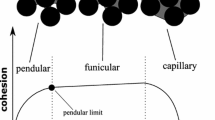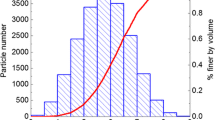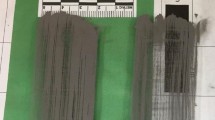Abstract
The critical state is an important concept for saturated and partially saturated granular materials as the strength and volume become constant and unique under continuous shear. By incorporating the water bridge effect, the mechanical behaviours of wet granular matters can be studied by the discrete element method (DEM). A series of DEM simulations are performed following the conventional triaxial loading path for dry and wet granular materials, and different suction values are applied at various confining stress levels. Unique critical state behaviours have been observed in both macroscopic and microscopic scales. It shows that the confining stress level plays an important role in the critical state behaviour of wet granular materials. The critical stress ratio for a wet material is not a constant value at different stress levels, and it is found that both the critical stress ratio and void ratio in wet granular matters are also much higher with a low confining stress. A framework is proposed by considering both the contact stress and the capillary stress effects to model the critical state lines. At large strain, the coordination number, the mean inter-particle force and fabric anisotropies evolve to constant critical state values for both dry and wet materials. The macro-parameters formulating the critical state stress ratio are found to be associated with the critical state anisotropies in solid skeleton and water phase fabrics, respectively.



















Similar content being viewed by others
References
Alonso EE, Gens A, Josa A (1990) A constitutive model for partially saturated soils. Géotechnique 40:405–430. https://doi.org/10.1680/geot.1990.40.3.405
Been K, Jefferies M, Hachey J (1991) The critical state of sands. Geotechnique 41:365–381
Been K, Jefferies MG (1985) A state parameter for sands. Géotechnique 35:99–112. https://doi.org/10.1016/0148-9062(85)90263-3
Berger N, Azéma E, Douce J-F, Radjai F (2015) Scaling behaviour of cohesive granular flows. EPL Europhys Lett 112:64004. https://doi.org/10.1209/0295-5075/112/64004
Bishop AW, Blight GE (1963) Some aspects of effective stress in saturated and partly saturated soils. Géotechnique 13:177–197. https://doi.org/10.1680/geot.1963.13.3.177
Chalak C, Chareyre B, Nikooee E, Darve F (2017) Partially saturated media: from DEM simulation to thermodynamic interpretation. Eur J Environ Civ Eng 21:798–820. https://doi.org/10.1080/19648189.2016.1164087
Christoffersen J, Mehrabadi MM, Nemat-Nasser S (1981) A micromechanical description of granular material behavior. J Appl Mech 48:339. https://doi.org/10.1115/1.3157619
Cundall PA, Strack ODL (1979) A discrete numerical model for granular assemblies. Géotechnique 29:47–65. https://doi.org/10.1680/geot.1979.29.1.47
Delenne J-Y, Richefeu V, Radjai F (2015) Liquid clustering and capillary pressure in granular media. J Fluid Mech 762:R5. https://doi.org/10.1017/jfm.2014.676
Duriez J, Wan R (2017) Contact angle mechanical influence in wet granular soils. Acta Geotech 12:67–83. https://doi.org/10.1007/s11440-016-0500-6
Duriez J, Wan R, Pouragha M, Darve F (2018) Revisiting the existence of an effective stress for wet granular soils with micromechanics. Int J Numer Anal Methods Geomech 42:959–978. https://doi.org/10.1002/nag.2774
Gabrieli F, Lambert P, Cola S, Calvetti F (2012) Micromechanical modelling of erosion due to evaporation in a partially wet granular slope. Int J Numer Anal Methods Geomech 36:918–943. https://doi.org/10.1002/nag.1038
Gallipoli D, Gens A, Chen G, D’Onza F (2008) Modelling unsaturated soil behaviour during normal consolidation and at critical state. Comput Geotech 35:825–834. https://doi.org/10.1016/j.compgeo.2008.08.006
Huang X, Hanley KJ, O’Sullivan C, Kwok CY, Wadee MA (2014) DEM analysis of the influence of the intermediate stress ratio on the critical-state behaviour of granular materials. Granul Matter 16:641–655. https://doi.org/10.1007/s10035-014-0520-6
Jefferies M, Been K (2000) Implications for critical state theory from isotropic compression of sand. Géotechnique 50:419–429. https://doi.org/10.1680/geot.2000.50.4.419
Khamseh S, Roux J-N, Chevoir F (2015) Flow of wet granular materials: a numerical study. Phys Rev E 92:022201. https://doi.org/10.1103/PhysRevE.92.022201
Kloss C, Goniva C, Hager A (2012) Models, algorithms and validation for opensource DEM and CFD–DEM. Prog Comput Fluid Dyn Int J 12:140–152
Kuhn MR (2016) The critical state of granular media: convergence, stationarity and disorder. Géotechnique 66:902–909. https://doi.org/10.1680/jgeot.16.P.008
Li X-S, Dafalias Y (2012) Anisotropic critical state theory: role of fabric. J Eng Mech 138:263–275. https://doi.org/10.1061/(ASCE)EM.1943-7889.0000324
Li X-S, Dafalias YF, Wang Z-L (1999) State-dependant dilatancy in critical-state constitutive modelling of sand. Can Geotech J 36:599–611. https://doi.org/10.1139/t99-029
Li X, Yu H-S (2013) On the stress–force–fabric relationship for granular materials. Int J Solids Struct 50:1285–1302. https://doi.org/10.1016/j.ijsolstr.2012.12.023
Lu N, Godt JW, Wu DT (2010) A closed-form equation for effective stress in unsaturated soil. Water Resour Res 46:W05515. https://doi.org/10.1029/2009WR008646
Oda M, Konishi J, Nemat-Nasser S (1982) Experimental micromechanical evaluation of strength of granular materials: effects of particle rolling. Mech Mater 1:269–283. https://doi.org/10.1016/0167-6636(82)90027-8
Radjai F, Richefeu V (2009) Bond anisotropy and cohesion of wet granular materials. Philos Trans A Math Phys Eng Sci 367:5123–5138. https://doi.org/10.1098/rsta.2009.0185
Richefeu V, Radjai F, Delenne J-Y (2016) Lattice Boltzmann modelling of liquid distribution in unsaturated granular media. Comput Geotech 80:353–359. https://doi.org/10.1016/j.compgeo.2016.02.017
Richefeu V, El Youssoufi M, Radjaï F (2006) Shear strength properties of wet granular materials. Phys Rev E 73:051304. https://doi.org/10.1103/PhysRevE.73.051304
Roscoe KH, Schofield AN, Wroth CP (1958) On the yielding of soils. Géotechnique 8:22–53. https://doi.org/10.1680/geot.1958.8.1.22
Rothenburg L, Bathurst RJ (1989) Analytical study of induced anisotropy in idealized granular materials. Géotechnique 39:601–614. https://doi.org/10.1680/geot.1989.39.4.601
Roy S, Luding S, Weinhart T (2017) A general(ized) local rheology for wet granular materials. N J Phys 19:043014. https://doi.org/10.1088/1367-2630/aa6141
Scheel M, Seemann R, Brinkmann M, Di Michiel M, Sheppard A, Breidenbach B, Herminghaus S (2008) Morphological clues to wet granular pile stability. Nat Mater 7:189–193. https://doi.org/10.1038/nmat2117
Schofield A, Wroth P (1968) Critical state soil mechanics. McGraw-Hill, London
Scholtès L, Chareyre B, Nicot F, Darve F (2009) Micromechanics of granular materials with capillary effects. Int J Eng Sci 47:64–75. https://doi.org/10.1016/j.ijengsci.2008.07.002
Scholtès L, Hicher P, Nicot F, Chareyre B, Darve F (2009) On the capillary stress tensor in wet granular materials. Int J Numer Anal Methods Geomech 33:1289–1313. https://doi.org/10.1002/nag.767
El Shamy U, Gröger T (2008) Micromechanical aspects of the shear strength of wet granular soils. Int J Numer Anal Methods Geomech 32:1763–1790. https://doi.org/10.1002/nag.695
Shen Z, Jiang M, Thornton C (2016) Shear strength of unsaturated granular soils: three-dimensional discrete element analyses. Granul Matter 18:37. https://doi.org/10.1007/s10035-016-0645-x
Singh A, Magnanimo V, Saitoh K, Luding S (2015) The role of gravity or pressure and contact stiffness in granular rheology. N J Phys 17:043028. https://doi.org/10.1088/1367-2630/17/4/043028
Sitharam TG, Vinod JS (2008) Critical state behaviour of granular materials from isotropic and rebounded paths: DEM simulations. Granul Matter 11:33–42. https://doi.org/10.1007/s10035-008-0113-3
Soulié F, Cherblanc F, El Youssoufi MS, Saix C (2006) Influence of liquid bridges on the mechanical behaviour of polydisperse granular materials. Int J Numer Anal Methods Geomech 30:213–228. https://doi.org/10.1002/nag.476
Tarantino A (2007) A possible critical state framework for unsaturated compacted soils. Géotechnique 57:385–389. https://doi.org/10.1680/geot.2007.57.4.385
Toll DG (1990) A framework for unsaturated soil behaviour. Géotechnique 40:31–44. https://doi.org/10.1680/geot.1990.40.1.31
Toll DG, Ali Rahman Z (2017) Critical state shear strength of an unsaturated artificially cemented sand. Géotechnique 67:208–215. https://doi.org/10.1680/jgeot.15.P.042
Toll DG, Ong BH (2003) Critical-state parameters for an unsaturated residual sandy clay. Géotechnique 53:93–103. https://doi.org/10.1680/geot.2003.53.1.93
Wan R, Duriez J, Darve F (2015) A tensorial description of stresses in triphasic granular materials with interfaces. Geomech Energy Environ 4:73–87. https://doi.org/10.1016/j.gete.2015.11.004
Wang J-P (2017) Force transmission modes of non-cohesive and cohesive materials at the critical state. Materials (Basel) 10:1014. https://doi.org/10.3390/MA10091014
Wang J-P, François B, Lambert P (2017) Equations for hydraulic conductivity estimation from particle size distribution: a dimensional analysis. Water Resour Res 53:8127–8134. https://doi.org/10.1002/2017WR020888
Wang J-P, Gallo E, François B, Gabrieli F, Lambert P (2017) Capillary force and rupture of funicular liquid bridges between three spherical bodies. Powder Technol 305:89–98. https://doi.org/10.1016/j.powtec.2016.09.060
Wang J-P, Hu N, François B, Lambert P (2017) Estimating water retention curves and strength properties of unsaturated sandy soils from basic soil gradation parameters. Water Resour Res 53:6069–6088. https://doi.org/10.1002/2017WR020411
Wang J-P, Li X, Yu H-S (2017) Stress–force–fabric relationship for unsaturated granular materials in pendular states. J Eng Mech 143:04017068. https://doi.org/10.1061/(ASCE)EM.1943-7889.0001283
Wang J-P, Li X, Yu H-S (2018) A micro–macro investigation of the capillary strengthening effect in wet granular materials. Acta Geotech 13:513–533. https://doi.org/10.1007/s11440-017-0619-0
Wang K, Sun W (2017) Anisotropy of a tensorial Bishop’s coefficient for wetted granular materials. J Eng Mech 143:B4015004. https://doi.org/10.1061/(ASCE)EM.1943-7889.0001005
Wang Q, Pufahl DE, Fredlund DG (2002) A study of critical state on an unsaturated silty soil. Can Geotech J 39:213–218. https://doi.org/10.1139/t01-086
Wheeler SJ, Sivakumar V (1995) An elasto-plastic critical state framework for unsaturated soil. Géotechnique 45:35–53. https://doi.org/10.1680/geot.1995.45.1.35
Zhao J, Guo N (2013) Unique critical state characteristics in granular media considering fabric anisotropy. Géotechnique 63:695–704. https://doi.org/10.1680/geot.12.P.040
Zhou W, Liu J, Ma G, Chang X (2017) Three-dimensional DEM investigation of critical state and dilatancy behaviors of granular materials. Acta Geotech 12:527–540. https://doi.org/10.1007/s11440-017-0530-8
Acknowledgements
The authors would like to thank the high-performance computing service at the University of Nottingham for implementing the DEM simulation programmes. The first author also appreciates the support of Taishan Scholar Project of Shandong Province of China during paper writing and revision.
Author information
Authors and Affiliations
Corresponding author
Ethics declarations
Conflict of interest
The author states that there is no conflict of interest.
Additional information
Publisher's Note
Springer Nature remains neutral with regard to jurisdictional claims in published maps and institutional affiliations.
Appendix: Calculation of direction tensors
Appendix: Calculation of direction tensors
For a granular assembly with \( N_{s} \) solid contacts (note that one physical contact point has two contacts), after Oda et al. [23], a moment tensor quantifying the directions of solid contact normals can be expressed as:
where \( \varvec{n}_{\varvec{c}} \) is the unit vector of the contact normal on the \( c \)th solid contact. Similarly, a second-rank tensor for water bridge network can also be raised. For a sample with \( N_{w} \) particle–water interactions (two times of total water bridge number), the moment tensor can be written as:
where \( \varvec{n}_{\varvec{w}} \) is the unit vector pointing from water bridge centre to particle centre on the \( w \)th water–solid interaction. The direction tensors of \( D_{ij}^{s} \) and \( D_{ij}^{w} \) consider the deviatoric part of the moment tensor being formulated as:
by taking the corresponding superscript.
For the directional distribution of contact forces, a second-rank moment tensor is also defined. By integrating the tensor product of the average contact force along a particular direction, the moment tensor noted as \( K_{ij}^{sf} \) can be expressed in a unit sphere space \( \varOmega \) as:
where \( \left. {{\mathbf{f}}_{{{\mathbf{cont}}}} } \right|_{{{\mathbf{n}}_{{\mathbf{c}}} }} \) is the average value for the contact forces in the \( \varvec{n}_{\varvec{c}} \) direction. The direction tensor of contact force, \( G_{ij}^{sf} \), is the deviatoric part of the contact force moment tensor in a normalised form:
Note that the directional mean contact force is \( f_{{{\text{cont}}0}} \approx K_{11}^{sf} + K_{22}^{sf} + K_{33}^{sf} \). Similar to the above procedures, the directional mean capillary force \( f_{{{\text{cap}}0}} \) can also be obtained from a moment tensor for the capillary forces which will not be repeated.
Rights and permissions
About this article
Cite this article
Wang, JP., Zeng, GH. & Yu, HS. A DEM investigation of water-bridged granular materials at the critical state. Comp. Part. Mech. 6, 637–655 (2019). https://doi.org/10.1007/s40571-019-00243-2
Received:
Revised:
Accepted:
Published:
Issue Date:
DOI: https://doi.org/10.1007/s40571-019-00243-2




